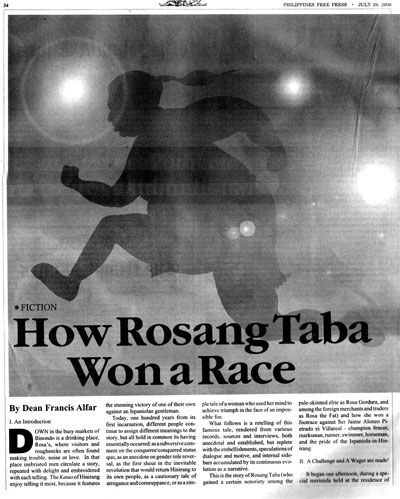Fully Booked and Powerbooks have some very interesting (and expensive) books which make me weep when I see them. Last night, shocked that it was there, I swooped down on the lone handsome hardcover copy of Linda Medley’s
Castle Waiting, flipped it, looked at the price and proceeded to have a mini-seizure. The price? P1,799 (US$29.95). Even with creative budgetary juggling, it was simply too much.
But
I
Wanted
It
So
So
So
Badly
Clutching it in my hands, I went around the other sections and found other books I also wanted, novels that ranged from P400 to P1,500, anthos with similar price points, new books (“fresh from the box”) that -
(
Whoa. An earthquake just softly rocked the office. It was surreal. We all stopped and looked at our things on the tables, the mini-Jurassic Park effect of my pomelo juice swishing in the cup, the terrible sense of vertigo that makes you doubt if maybe, just maybe, it’s you who’s dizzy. I made a crack and asked out loud “Okay, so who’s going to panic and run screaming down the stairwell?” as we calmly walked to the door. It’s over now, but it makes you think. Think, think think. Anyway, back to the post…)
And yet, people buy them. Which is how bookstores stay in business.
So obviously the business model works, which is how these bookstores are able to stock new books every so often. People spend money on books.
If people can spend money on new foreign books, why can’t they spend money on new local publications? Why is there the argument that local books should be cheaper? The usual answer is that Filipinos will only buy cheaper books, that it is a matter of economics, of budgets, of affordability – but it does not change the fact that Filipinos still buy the expensive new foreign books. On the whole, new foreign books are more expensive than books published here (and they also have better paper stock). So why doesn’t this market buy more Filipino books, even if they’re cheaper?
Is it because the imported books have “name” authors (but the shelves are also filled with lots of unknowns or first time authors or crappy authors)?
Is it because we are conditioned to treat imported books as somehow special and worth spending more on (and conversely, our local books, being local, must be cheaper and worth less)?
Is it because these books – pop, fiction, mystery, chick lit, spec fic, children/young adult - are better written (but really, a lot of them are not, and it creates the impression that Philipine literature, in general, is poorly written in comparison, which brings us to fore the tried and true "colonial mentality" thing)?
If the argument is that “The Filipino cannot afford expensive books”, why are the bookstores in business (and note that majority of their sales is in foreign books)?
We are talking about a specific market here, being (for the sake of discussion) “Filipinos who buy books at Fully Booked and Powerbooks”. I make this distinction so that the social realists out there will not assault me with the grainy pictures of emaciated little children, tilling the fields in the provinces, dreaming about their next meal, a better tomorrow, and considering following their brothers into the mountains to fight against a government to whom they are invisible – that, obviously, is a separate market, for a separate discussion.
We’re talking about people who willing and able to spend money on books, confident that their next meal is not in question - and in particular, just to narrow down the discussion, to those who buy new books at Fully Booked and Powerbooks.
New imported stock versus newly launched Filipino book. Price points: imported books are more expensive (if you don’t believe me, I will either show you my receipts or show you the books themselves at the bookstores). Which is bought more? Imported books. Apart from Filipino chick lit, majority of Philippine books have print runs under 500 or 1,000 units (which does not give Filipino publishers the economies of scale benefits of huge print runs, which makes an individual copy of a Filipino book cost more – BUT still generally cheaper than imported books). If a Filipino book breaks 1,000 units sold, it is pronounced a “bestseller” – that is something both sobering and sad, given the number of people in the specific market under discussion (and even worse if we consider the number of literate people in the country – and absolutely terrible when we think about the entire population of the country).
New imported books & new Filipino books versus Booksale A funny thing. You know those Booksales and other purveyors of secondhand books? Generally speaking, their price points are lower (because of the secondhand nature of their books, though actually a number of them are in fact not secondhand, but returns and such – if you see a book with its cover deliberately removed, that book was returned to be destroyed by the original bookstore/seller and the neither author nor publisher are paid for it).
Some people buy books there and then compare the price to the retail price of new Filipino books in Powerbooks or Fully Booked. Of course, generally speaking, the imported books at Booksale are a lot cheaper. They are also cheaper than brand new imported fiction.
A reader recently pointed out that for the price of Philippine Speculative Fiction Vol.1 (P300), he could have purchased 2-5 books by big name authors at Booksale. But of course. Same argument for any of the new fiction at Fully Booked, across the genres, both imported and local. Is it fair to compare an old worn P30 copy of Asimov at Booksale to the price points of new pocketbooks, trades and hardcovers at Fully Booked?
There are people like me, part of the specific market under discussion, that want certain new books immediately, while also more than willing to root through tons of crap at Booksale for the rare used book. But I do not compare the two – it’s apples and oranges, though they’re both fruit. On a side note: on occasion, special copies of of very new books appear at Booksales and similar stores –
Banzai Cat scored copies of Ford’s “The Girl in the Glass” and Clark’s “Jonathan Strange & Mr. Norell”, so it pays to dig through. I happily found an early volume of “The Year’s Best Fantasy & Horror”, nice, thick, tall and almost new. And when I’m at Shoppesville in Greenhills for lunch, I stop by the Booksale there and pick something up, so that I have something to read at Le Ching (hmmm… pork tausi spareribs with chili sauce…).
If people (again, in the specific market under discussion – “Filipinos who buy books at Fully Booked and Powerbooks”) can afford to buy new imported books at those prices, then certainly then should be able to shell out money for new Filipino books, which generally speaking are cheaper than imported books (the reason I hedge is that there are a few Filipino books that do break the mold, like Best Philippine Short Stories or the erotica antho). My antho at P300 is cheaper than majority of the imported pocketbooks and definitely costs less than similar imported anthos.
On comic books/graphic novels, our latest book Siglo: Passion, full color and released December last year, retails at P800. Take a look at the graphic novel sections of Fully Booked and Powerbooks and you will see that a large number of the imported trades retail for more (I know because I collect them myself). The US$10 trade paperback is becoming rarer and rarer. I think one of DC’s best offers is at US$12.95. Most of DC, Marvel and indies trades/graphic novels retail at US$15, $18, $20, $25 and higher. There are special editions (Absolute, etc) that go for $75, $100 or more. Our other December release, Project: Hero is priced at P120, at par with the baseline US comics, but with more pages (in black and white). Other imported independent black and white comics cost more.
So if it is a market forces argument, we cannot discount the fact that all the imported books – fiction or graphic novels – continue to consistently move and sell at their prices. Who is buying these books? Filipinos, of course. So the question is why don’t they buy more Filipino stuff, if they can apparently afford the new imported stuff? Is because we think work by Filipinos is inferior and thus not worth spending money on?
It could be preference, yes, but part of developing the scene is learning about differences and supporting our own.
More soon.























